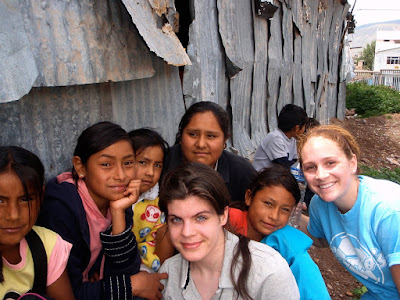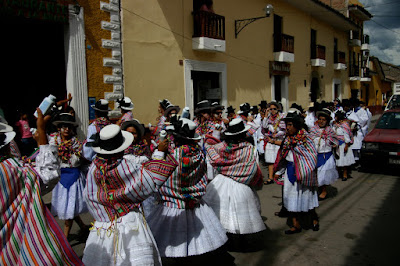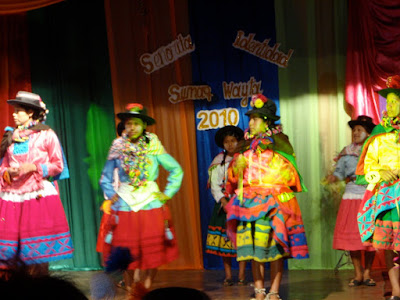(This is a long one, but there are lots of pictures below!)
Working at Santa Elena Health Clinic today was great. I went there with three other people, and worked in the same area as one of the girls, Laura. We observed an Obstetrician, which was really amazing. I noticed that the doctor-patient relationship was very much the same as in the states. The doctor was very professional, and well educated in her trade. Patients listened attentively, and trusted the advice she presented. The outstanding difference, though, was the setting. Unlike Los Licenciados, which was a brand new government-funded building, Santa Elena is pretty much a house. The paint is chipping, the floors are dirty, furniture is scarce, and medical equipment is very rudimentary. Laura is an EMT, and noticed that the supplies and equipment at Santa Elena are similar to those found in an ambulance: basic and few.
At the beginning of the day, pregnant women from the surrounding neighborhood line up outside the door to the doctor’s office, and wait until they are called. Some may wait over three hours for their appointment, as there is only one Obstetrician working on a given day, and there are no “time slots”. Patients are told a day to show up, and they are seen in the order they arrived. If you get there too late, you might not be seen that day. There just aren’t enough resources to run the clinic otherwise.
Every appointment we saw was different, but one common theme throughout the day was diet; la alimentación. The doctor asked every patient what they were eating, how often, recommended proteins over fruit, and told them to eat balanced meals. I’m sure this is a key topic for pregnant women around the world, but it seemed especially important here, as a decent, balanced diet is not a given in many cases. Around noon, a woman who had been anxiously waiting outside all morning came in and told the doctor about “unos duelitos” (little pains) that she was having. She was in labor, and the doctor did an exam to see how far along she was. The woman was only dilated 1cm, so the doctor instructed her to walk around as much as possible the rest of the day, breathe deeply when the contractions hit, and come back when they were closer together. This being her first baby, and only 22 years old, she left looking scared and in pain, and I couldn’t blame her. Yet regardless of the fact that the setting for delivery is primitive, I’m sure she will be fine.
After lunch, we did a whirl-wind trip to the market to buy our costumes for Carnaval. It’s looking like I’ll be dancing THREE separate times this weekend: Tomorrow at the Prison (sounds weird, but I’ll explain in a minute), once on Saturday with the staff of Santa Elena, and once during the big parade on Monday. HA! Should be interesting. We learned the steps last night, and they are pretty simple, so hopefully we won’t have too much trouble.
As for the prison, it’s one of the places our volunteers go, and their job there is to socialize with the imprisoned women. The female prisoners are mostly undeserving victims of the Cocaine trade, i.e. they were in the wrong place at the wrong time. Our program director, Rudy, was saying that many of them had either been forced (by their husbands) to smuggle Cocaine and were caught, or their husband was caught, the authorities later found Cocaine in their house, and tossed the wife into jail for good measure. The most depressing part about all this is that many of the women have young children, who until the age of four live with their mothers in the prison. They really have no other choice. On top of that, women are put in cells meant to sleep three or four people with almost eight or nine. So having volunteers there is great for them. Volunteers play with their kids, socialize with the women, and take their crafts to sell in the city once a month. I haven’t been there yet (I will be going Thursday and Friday), but from what I hear it’s a very rewarding experience.
After buying costumes at the market, we went to Quinua and the Wari ruins. Quinua is a small artisan town up in the hills, near the Peruvian Independence monument. They specialize in ceramics, and the town is very cute.
Adorable kid at a ceramic shop
Above is my favorite picture I've taken so far.
Peruvian children are beyond cute.
I just liked the sign.
As for the Wari ruins, they are the remnant of the Wari civilization, which existed 4,000 years prior to the Inca. The ruins were nothing like Macchu Piccu; there are only some partially excavated tombs, houses, etc., but it is interesting just the same. (See picture below)
This is thought to have been the spout of a Wari water fountain
As you can probably tell from the length of this blog, today has been a long day. I’m ready to sleep tonight!
Side note: Below is a picture of the CCS Ayacucho Program director, Rudy. This picture really sums him up, haha. The thing in the middle of the river is how he gets to his "Country Home" and back. Apparently there is a real bridge going in soon... I think that's for the best.














































